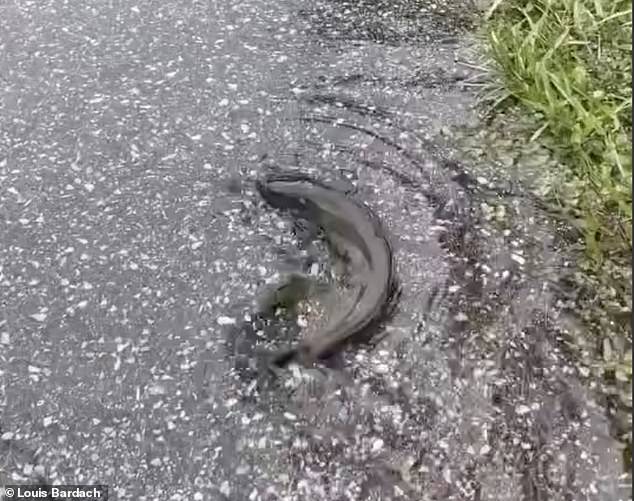Residents of storm-battered Florida might have felt the sea was reclaiming the state during Hurricane Debby, and it seems like some of the local wildlife had the same idea.
As the Category 1 turned streets into rivers, some were alarmed to see their neighborhoods being stalked by walking fish spookily adapted to the amphibious conditions.
Social media was awash with footage of the slimy looking creatures boldly flapping across their yards after being dredged up from their hiding places by the storm.
And residents were not reassured after wildlife experts identified them as 'Walking Catfish', a species native to southeast Asia that has been slowly increasing in Florida since their first sighting there in the late 1960s.
'Wow! Yikes! Who knows what else might show up out there,' wrote one. 'Be safe out there.'

Louis Bardach found one 12-inch specimen eyeing him suspiciously on his driveway

The creature flapped off down the Gulfport driveway when Bardach tried to poke it
The storm was still gathering when Louis Bardach found one 12-inch specimen eyeing him suspiciously on his driveway in Gulfport.
'It's very much alive,' the homeowner remarked as he filmed it for Instagram.
The creature sprang into life and began wriggling off across the asphalt as Bardach attempted to poke it with a finger, flapping from side to side like a giant tadpole.
'Not sure where it's come from or where it's trying to go to,' Bardach said.
'Weird! Alright maybe we'll help it along.'
Not everyone was as sympathetic in a state that is no stranger to peculiar wildlife.
'Hopefully you helped it to the fryer,' wrote one,
'Walking catfish invasive species. Should have killed it,' added another.
The Florida Fish and Wildlife Commission says the animals are identified by their 'elongated, gray, and scale less catfish-type body with a large mouth, sharp pectoral spines and four pairs of barbels'.
And they describe its shuffling along land as 'like an infantry-man scooting under barbed wire'.

Another specimen was bucketed up from a driveway in St Petersburg

Hundreds of the walking catfish were reported to be frolicking in yards, lawns and driveways after Hurricane Ian hit Florida in 2022
Noodling fans who might fancy testing themselves against the catfish might take note that they do not have fish scales but rather are 'covered in a slippery mucus that protects their skin when out of the water', according to the Florida Museum of Natural History.
Most commonly found in the Everglades and the connecting waterways and they 'can live and even thrive in water with little to no oxygen'.
Some of the population lives in storm drainage systems and it is they which are likely to have popped up in residential areas during the disruption from Debby.
Despite their unnerving appearance they are 'good parents', the museum notes, and it is 'the males who build nests in underwater vegetation, and they protect the eggs and then the young babies'.
'This added protection from the males at an early stage helps make walking catfish more successful as an invasive species.'
Early fears about their impact on native species have proved exaggerated, but they are 'still considered undesirable,' according to the Commission.
'They can only be possessed dead, so anglers who want to try eating them should immediately put them on ice,' it adds.
A St Petersburg man fond another two in his driveway, and 14 fished up in a Merritt Island backyard in the aftermath of Hurricane Ian two years ago.
Some were sympathetic to the plight of the fish out of water after stumbling across them in the latest deluge.
'Saw this the other day when I went on a run,' wrote one. 'I had to put the poor critter in a bucket and bring it back to a pond or spring.
'They can stay alive for up to a day or so as long they stay wet which in that weather won't be an issue,' wrote another.
'It can also smell/taste the scent of the nearest pond or river and will eventually get itself to it. If you see one probably best to leave them be.'
But others were distinctly unimpressed by the web-footed creepy-crawly.
'Omg. People don't react this kindly to most people,' snapped one.
'It's a stupid fish that feeds on mud, tastes like dirt too.'











































































































































































































































































































































































